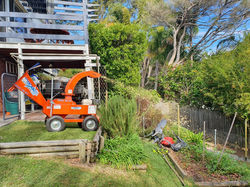About Everydayarbor
Everydayarbor was established by Sam Hardingham to provide a different approach to managing trees - retaining them for as long as possible in the urban forest.
During his extensive career as an arborist, Sam saw the removal of a number of great trees and the destruction of important habitat. Sam now uses his knowledge of trees to protect and enhance the urban forest. With expert knowledge, trees can be retained for longer in the landscape, and provide vital ecosystem services and biodiversity connectivity.
Tree retention, habitat creation, tree pruning, hazard mitigation, tree selection and tree planting are all part of the specialist services that Everydayarbor provides.
 |  |  |  |
|---|---|---|---|
 |  |  |  |
 |  |  |  |
 |  |
Our Services

Site Visit
The reasons Everydayarbor charges for Quotes
In order to provide clients with unbiased advice, a call out fee is charged.
Most tree companies provide free quotes, but if the tree requires no work, or the proposed works will have a poorer outcome, how can a good result be achieved when the operator is left out of pocket for time spent providing free advice.
A $150 fee is charged to visit site.
If there are works required, a complementary quote will be provided.
This small fee mitigates having to conduct works that may be unnecessary, potentially saving you thousands of dollars.
Services

Pruning and Hazard Mitigation
In general, trees will look after themselves. When they're close to infrastructure or people they may require some assistance.
Correct pruning can prolong the life of a tree in an urban environment, reduce hazards, provide clearance from infrastructure and increase aesthetic value.
All work completed by Everydayarbor is undertaken with integrity and with the intended best outcome for your trees. Working to the latest Minimum Industry Standard for Tree Pruning (MIS308), you can be sure that your piece of the urban forest is being cared for by the most up-to-date knowledge of arboriculture
Habitat Creation and Installation
Tree hollows take decades to form and are essential for more than 300 species of native animals.
Some trees are suitable for hollows to be carved directly into the them using a chainsaw. Others can have custom made habitat logs installed.
Working to the latest Minimum Industry Standard for Environmental Arboriculture (MIS312) will achieve the best possible habitat outcome for the tree in its current situation.
Where a tree cannot be retained, Everydayarbor will offer to re-purpose the logs for ground habitat, or use them as log hollows for a future habitat installation.

Trees Are Important
We need trees to survive
Some of the benefits of trees include:
Clean Air: trees provide oxygen and intercept pollutants in the air
Energy Conservation: trees act like a natural air conditioner, evapotranspiration cools the air and tree canopy can shade your property - keeping your air conditioning bill lower in summer
Mitigate Climate: trees sequester carbon and help reduce the concentration of greenhouse gases in the atmosphere
Water filtration and retention: trees reduce storm water run-off and aid in flood mitigation. Trees also filter water and promote beneficial water quality
Privacy: trees provide a screen and can soften the view of industrial and commercial areas
Habitat: so many of our native species call trees their home. Trees also provide food and respite for wildlife


Tree Planting
What sort of arborists would we be if we weren't at least sustaining our existing canopy cover? BAD is the answer.
Tree planting is a service many arborists forget to offer.
Selecting an appropriate species for the location is just as important as how its planted.
The trees we plant now have the potential to last multiple human lifetimes, so getting it right should be a top priority.
Everydayarbor can select, source and plant trees for you. It might not cost as much as you think, and is a gift that keeps giving!
VALID Tree Risk-Benefit Assessment
Trees can be a worry, but is the risk tolerable when compared to other hazards we may encounter on a daily basis?
Sam has received training and is fully insured to use the tree risk rating system called VALID.
An assessment of the tree and site is conducted. The the data is entered into the app to produce a risk rating using a simple traffic light system.
If the risk rating is Green-low, you have completed your due diligence, you will be issued a report and will be advised when the next inspection should be conducted.
The other outcomes could be:
-
Amber-Tolerable. Risks will not be reduced but may require an increased frequency of assessment than Green-Acceptable risks.
-
Amber-Not Tolerable. Risks will be reduced to an Acceptable level, but with a lower priority than Red-Not Acceptable risks.
-
Red-Not Acceptable. Risks will be reduced to an Acceptable level.
Whether the tree is on your property or your neighbours, and if its them that have concerns or you, put your mind at ease with a tree risk rating report.
Compared to tree removal, this is the cheaper and more sustainable way of managing risk.
Starting from $75.



Tree Removal*
Everydayarbor is accomplished in all aspects of tree climbing and rigging, able to remove the biggest trees in the most challenging locations, but there is a reason this is the last service on list, and not first.
When a tree has already fallen or is moving in the ground, the decision to remove it can be obvious. Often, this is not the case and there is much to consider.
It's easy to put a price on the physical removal of a tree from the landscape, but difficult to determine the real cost to human health and wellbeing and the impact on the environment.
Trees take decades to become mature, and once they reach this stage, can last for many more, sometimes with little to no maintenance.
If you're considering tree removal, call Everydayarbor to discuss options for the trees on your site and how to achieve a better greening outcome.
*Everydayarbor will not remove trees for reasons such as:
-
Leaves on lawns or hard surfaces. Buy a leaf blower.
-
Leaves in gutters or pools. Trees clean up after us, so we should be expected to return the favour from time to time.
-
Bird droppings or excessive fruit fall. Move the target or install garden bed.
-
Views. The tree is the view and is likely to be blocking other people from seeing your house.
Projects
Some examples of projects Everydayarbor has worked on
Hollow Carving to Create a Living Habitat Tree
Tree management. Reduction pruning
Mistletoe Project with Birdlife Australia


Hollow Carving to Create a Living Habitat Tree
Garden Suburb Public School
During an arboricultural assessment of the trees at Garden Suburb Public School, this Blue Gum was identified as having a structural issue.
With the assistance of Everydayarbor, the tree canopy was reduced and habitat was created using specialist chainsaw techniques. The Blue Gum was retained in the landscape for its provision of ecosystem services and the kids keep an active eye on the tree to see what kinds of wildlife might use it.
Keeping the tree alive will help maintain active root growth for stability and provide insulation for the hollows, which has greater thermal properties than non-living timber.
Within a few weeks there were signs of wildlife activity around the top hollow entrance.
Habitat Log Installation
Cardiff
A small habitat log was created and installed in a living Gum tree using non-invasive fixtures. The Gum was in good health in a back yard in Cardiff. It was too young to host any natural hollows but in a good location to provide connectivity for native wildlife.
Within weeks of the installation, a pair of scaly breasted lorikeets moved in and laid eggs. The small log was installed just at the right time and the tree owners were able to watch the lorikeets as the eggs hatch and the chicks fledged the nest.
Tree management. Reduction pruning
The Tree
This Liquidambar in Whitebridge was planted by the residents 45 years ago. Their children and grandchildren have grown up climbing it. On Mother’s Day each year, the family come round to have photos taken in the autumnal foliage. This tree is loved, and the owners say ‘our yard would be nothing without it’.
Tree History
Some years ago, a large branch failed during a storm, leaving a cavity on the main stem and a gap in the canopy that is still visible. Since then, arborists have reduced and maintained the tree’s size at least a couple of times. The aim of this has been to prevent further failure. As you can see from the before photos, the tree has good vigour, with over 4m of new growth on some parts. But, the lack of wound occlusion indicates this new growth has a poor attachment to the branch (trees seal, they don’t heal). All that new growth connected by a poor attachment means as those branches get larger, they could be more likely to fail.
The treatment
To maintain it for as long as possible and to reduce the risk of branch and stem failure, the trees height and spread has been reduced again. Using hand tools, and doing it now rather than later, creates only small diameter wounds for the tree to seal, rather than a big one. Also, it’s more likely to re shoot from younger growth.
The residents have already been using the fallen leaves as mulch. All cuttings were chipped on site and used to extend the existing mulch line. This helps to retain moisture in the soil and return nutrients, therefore improving growing conditions for the tree.
The tree will be monitored and a shorter interval between pruning may be adopted if it recovers well.








Mistletoe project with Birdlife Australia
There are many myths about mistletoe. Requests are still made for arborists to remove it from trees because of the misconception that mistletoe kills trees.
In the words of mistletoe expert Dr David Watson, "Mistletoe kills a tree as often as a flea kills a dog".
In 2015 a fire spread through half of the Hunter Economic Zone in the Hunter Valley. Mistletoe is not tolerant of fire and approximately half of it was wiped out.
The woodland is recovering well and Birdlife Australia have been working hard to restore mistletoe to areas which once had it.
To find out more about the critically endangered Regent Honeyeater and why this project is so important, follow the links below.
https://www.audubon.org/magazine/fall-2020/can-critically-endangered-bird-survive-australias
https://birdlife.org.au/documents/Landcare_Mistletoe_newsletter_article_final.pdf
Gallery
Please select a photo to view a larger image
 Mulch in back yard |  Back yard Tommy |
|---|---|
 Germinated mistletoe |  Mistletoe bag |
 Chipper |  Ready to chip |
 Hollow carving |  Bird eggs in hollow soon after installation |
 Live habitat tree |  Live habitat tree with wound |
 Activity at top hollow |  Live habitat tree |
 Face plate |  Pearson Street Mall |
 Hollow carving |  Tree climbing |
 Hollow carved into live tree |  Recently hatched chicks in natural hollow |
 Tree removal with crane |  Hollow carving |
 Tawny frogmouth |  Hab box |
 Grub in back cut |  Shadow |
 Tawny frogmouth |  Possum in natural hollow |
 hab box 2.jpeg |  hab box |
Contact
If you have any questions or would like to book a consultation, please call or email Sam:
0431 191 097











